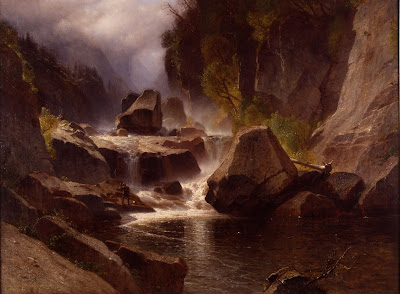In the Adirondack Mountains
In many ways art is like a particularly vivid dream- it feels so real when you fall into its grasp.
Here's perhaps my favorite oil by Asher Durand, one of the key Hudson River School painters. Usually he busied himself lovingly painting forest interiors. Sometimes his studies of trees almost feel like portrait paintings. But this one is atypical as the rocks get the starring role. He's down in the gorge painting the Ausable River in the Adirondack Mountains in northern New York State.
Because Durand wanted you to have a deep experience of his river he didn't just paint what he saw. Instead he had to first envision the scene in his pictorial imagination. He had to see it in different terms than it really was. In a way he had to make a better gorge than the one nature had provided him.
Now this was a really hard painting to pull off. Potentially the rocks could have all competed with each other for our attention (as they do in so many other less successful paintings). But Durand skillfully charts a course around that trap.
Most important of all is that he decided he wanted to paint the space of the gorge. All his subsequent decisions follow from that. In his mind he carefully constructed the space divided into three contiguous zones. He controlled what was happening with the forms within each zone so they'd stay put like well rehearsed players in a marching band. Everything in the foreground is toned down toward a middle grey tonality and a nearly neutral grey hue.
As you approach the first prominent boulder in the river things change. From there back to more distant green-brown foliage things get much higher in tonal contrast (white water against strong darks). Any warm hues to be found in the painting are strictly fenced into this middleground zone.
Then moving farther back into the space he changes gears again- dropping an imaginary translucent curtain of cooler blue-grey colors over the far distance. It pulls the extremes of darks and lights we'd found in the middleground back towards middle greys again. And like a real curtain, it obscures what perhaps was a too complicated distant space that would have competed with the middle ground's key players. Durand here is exercising restraint, sensing that few rocks will be more powerfully expressive than many.
There's an old saying by Degas that "an artist needs the cunning of a criminal." He's talking about the little lies artists tell in the service of a bigger truth they've discovered. It's funny as the words "truth" and "beauty" were bandied about all the time in the 19th century to describe the goals of art. Nowadays arts writers would rather die than use such outdated language. But those words were just how people 150 years ago talked about the struggle to create something that felt ultimately real. For me Durand's Ausable river feels more real than the actual place. He did it by selecting, editing, adjusting, and finally, lying,



